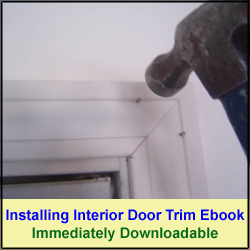What to Look for when Buying Interior Doors
By Mark J. Donovan
|
|
In the world of interior doors, not all interior doors are created equal. Interior doors are fabricated out of various types of material, and come in many shapes and sizes.
When buying interior doors you will be faced with the question on what type of doors are you looking for? There are many interior doors to choose from. There are solid interior doors, hollow interior doors, blank doors, pre-hung doors, flat surface doors, and paneled doors to name a few of the options. |
Left Hand versus Right Hand Doors
Then there is always the question on whether or not you need a right hand door or a left hand door. If you have to pull the door open towards you with your right hand, because the doorknob is on the right hand side of the door, it is a right hand door.
If you have to pull the door open towards you with your left hand, because the doorknob is on the left hand side of the door, it is a left hand door.
|
Interior Door Sizes Interior Doors come in a variety of widths and heights. When describing an interior door’s width, it is usually expressed as a 2’ 6” width (e.g. for a 30 inch door), or a 2’ 8” width (e.g. for a 32 inch wide door). When it comes to describing an interior doors height it is usually expressed as a 6’ 6” length (e.g. for a 78 inch door) or a 6’ 8” length (e.g. for a 80 inch door). |
|
These examples are just a couple of the standard interior door sizes. Interior doors can also be purchased in several other standard sizes. The interior door thickness is typically 1 3/8”. This is common throughout all standard interior door styles.
Before removing the strike plate use a pencil to trace around the perimeter of the strike plate. Use you chisel to remove 1/16th to 1/8th inch of wood material in this area. Basically you want to remove an amount that is the thickness of the strike plate.
Once you have chiseled out the wood material reinstall the strike plate and confirm that the strike plate is sitting flush with the door jamb. Try closing the door and see if it latches properly. If not, then continue on with this article.
The solid interior paneled doors are more expensive, due to the fact that they are using solid wood. Solid wood panel interior doors are usually hold up better and are easier to trim then hollow MDF doors.
Hollow MDF paneled doors have a small solid section at the top and bottom that you can trim. If you trim the door beyond the solid section you will destroy the hollow door, as the door will lose its structurally integrity. Unlike solid paneled interior doors, Hollow MDF interior doors are less likely to swell or bind with an increase in humidity levels. However, like all hollow interior doors they can be easily damaged and offer minimal soundproofing.
| Flat Surface Interior Doors
Flat surface interior doors, also known as flush doors, have smooth, flat surfaces throughout the entire length and width of the door. Hollow flat surface doors are quite common and inexpensive. They are usually constructed out of a wood veneer surface and a honeycomb core. Again, trimming them can be tenuous as you can quickly destroy the door if you cut too much off the top or base of the door. |
 |
Again, like all hollow interior doors they can be easily damaged and offer minimal soundproofing.
Pre-Hung Interior Doors
Pre-hung interior doors include the outside door trim, door jamb and the door itself. The outside door trim and door jamb come in two units that clam shell together around a rough door frame.
They are extremely easy to install and as a result are very popular interior doors. Prior to installing the door trim and door jamb, the interior door is removed and put aside. Once the two interior door trim and door jamb pieces have been installed into the door frame the door is then reattached to the hinges. As with most interior doors, the hole for the door knob is already pre-bored, so a standard door knob can easily be installed.
Interior door blanks are just the door itself. They can be used to install in existing door jambs. They can be more of a challenge as the door hinge areas need to be chiseled out.
So before going out and buying interior doors, make sure you know what “hand of doors” you required, e.g. left hand or right hand. Also consider whether you want hollow or solid doors and make sure your choice is consistent with your home’s interior look and budget.
For information on how to install interior door trim, see the “Installing Interior Door Trim” eBook from HomeAdditionPlus.com. The “Installing Interior Door Trim” eBook provides step-by-step instructions on how to install interior door trim. Pictures are included for every key step in the process.
Related Information
Additional Door Resources from Amazon.com
 |
 |
Free Home Addition Price Quotes with No Obligation!
Fill out our 3-5 minute quick and easy form, and receive a free price quote on a house addition from one of our prescreened and licensed home addition contractors. This process is free and there is no obligation to continue once you receive your house addition price estimate.


